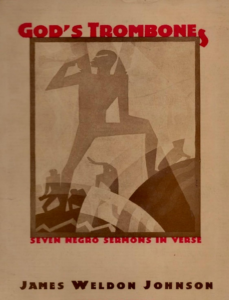The Voice of a Trombone
“He strode the pulpit up and down in what was actually a very rhythmic dance, and he brought into play the full gamut of his wonderful voice, a voice—what shall I say? —not of an organ or a trumpet, but rather of a trombone, the instrument possessing above all others the power to express the wide and varied range of emotions encompassed by the human voice—and with greater amplitude.”
— James Weldon Johnson, Preface to God’s Trombones
Folk Sermons in Black Preaching
I remember hearing in my boyhood sermons that were current, sermons that passed with only slight modifications from preacher to preacher and from locality to locality. Such sermons were: “The Valley of Dry Bones,” which was based on the vision of the prophet in the 37th chapter of Ezekiel; the “Train Sermon,” in which both God and the devil were pictured as running trains, one loaded with saints, that pulled up in heaven, and the other with sinners, that dumped its load in hell; the “Heavenly March,” which gave in detail the journey of the faithful from earth, on up through the pearly gates to the great white throne. Then there was a stereotyped sermon which had no definite subject, and which was quite generally preached; it began with the Creation, went on to the fall of man, rambled through the trials and tribulations of the Hebrew Children, came down to the redemption by Christ, and ended with the Judgment Day and a warning and an exhortation to sinners.
Learning to Hear
Several years ago, to learn more about these preachers and share their messages with the church in our small, mostly white community, I led a small group titled, after Johnson’s book of poems, “God’s Trombones: Celebrating Black Preaching.” I have recently revised the sessions to present in a new setting and offer them here on my website for use by others.
Rather than begin with preachers and their sermons, I begin with James Weldon Johnson. The poetry in God’s Trombones is borne out of the sermons Johnson grew up hearing and trains our ears to hear the distinctive elements of historic African American preaching. Included here are my discussion questions and quotations that guided our hearing of Johnson’s poetry and the sermons that would follow in subsequent weeks.
Elements of Black Preaching
“The Black imagination adds appropriate dimensions and details to the biblical protagonist, whether an individual or a group. It is common in Black sermons to hear lengthy and gripping discussions of Bible characters. The instinctive attempt is made to speak of the biblical person in the way one who had known him or her would speak.” – page 64
Black Preaching: The Recovery of a Powerful Art, by Henry H. Mitchell


Opening Questions
-
Have you ever experienced or observed a sermon from the African American tradition? If so, what stood out to you?
-
From the top of your head, what are some of the distinct elements of black preaching that stand out to you?
- Possible responses: Call and response/audience participation, repetition.
Elements of Black Preaching: Personification
"A Black rendition of scripture does in language what a Black Christ or Black Madonna does in art; God is divested of a "proper," White, socially distant image." - page 83
Black Preaching: The Recovery of a Powerful Art, by Henry H. Mitchell
The Creation, by James Weldon Johnson
In The Creation, James Weldon Johnson presents God as a lonely old man, pacing and pondering before bringing the world into existence. This portrayal humanizes God, making Him deeply relatable, particularly within the African American experience, where themes of solitude, resilience, and creative power resonate.
Johnson’s use of Black imagery, such as describing the newly made Earth as looking “like a mammy bending over her baby,” draws on the familiar warmth and care of Black motherhood. This comparison not only reflects the intimacy of God’s relationship with creation but also grounds the divine act in the shared cultural experience of family, love, and nurturing care.
Discussion Questions
-
What imagery or lines stood out to you the most, and why?
-
What do we know about the style of black preaching? How does Johnson’s use of rhythm and repetition contribute to the emotional impact of the poem?
-
What emotions does the poem evoke, and how do you think Johnson intended his audience to feel?
-
Here’s a theological question: Was God lonely before creation? No! Father, Son, and Holy Spirit were in perfect communion.
-
So why is God presented as lonely?
-
Who is God in this poem? He’s an old man.
-
Put it in Cultural context: “Nobody knows the trouble I’ve seen. Nobody knows but Jesus.”
-
-
Elements of Black Preaching: Repetition
"In truly Black preaching, repetition occurs not only in the call and response, but also in the normal course of the sermon. Texts, aphorisms, and other significant statements are restated for emphasis, memory, impact, and effect." - page 92
Black Preaching: The Recovery of a Powerful Art, by Henry H. Mitchell
The Prodigal Son, by James Weldon Johnson
In The Prodigal Son, James Weldon Johnson employs repetition as a powerful rhetorical device, echoing the call-and-response style of Black preaching to reinforce the poem’s message. The repeated warnings and pleas serve both as a literary technique and a sermon-like exhortation, emphasizing the consequences of straying and the deep yearning for redemption.
At its core, the poem underscores the importance of family and remaining in community, portraying home as not just a place of return but a source of identity, belonging, and grace. Through the father’s unwavering love and the son’s journey of repentance, Johnson affirms the enduring value of kinship and the redemptive embrace of those who welcome the lost back into the fold.
Discussion Questions
-
What emotions or images were most vivid to you in this retelling of the parable?
-
What roles do repetition and rhythm play in conveying the message of the poem?
-
How does Johnson’s language invite the audience to see themselves in the story?
-
What connections can you make between this poem’s themes and the struggles faced by African American communities during Johnson’s time? Are those themes still relevant today?
Elements of Black Preaching: Emotional Experience
"When Black preachers are most persuasive, they are apt to seem more to plead out of passion than to argue out of logic. They seek to guide the hearers in an experience, rather than to overwhelm them with intellectual evidence, even though they may use it well." - page 144
Black Preaching: The Recovery of a Powerful Art, by Henry H. Mitchell
The Judgment Day, by James Weldon Johnson
In The Judgment Day, James Weldon Johnson uses vivid imagery and a commanding, rhythmic cadence to create a powerful emotional appeal, evoking awe, urgency, and even fear.
The poem’s preacher-like voice calls listeners to reckon with the inescapable reality of divine judgment, painting a dramatic scene of God’s final authority over creation. Johnson’s language, rich in repetition and striking contrasts, heightens the sense of inevitability, warning that when the trumpet sounds, there will be no second chances.
This finality underscores the weight of moral choices, reinforcing the traditional Black preaching style that blends warning with an impassioned plea for righteousness before it is too late.
Discussion Questions
-
What was your emotional reaction to the poem? Which lines or moments impacted you the most?
-
How does Johnson’s use of vivid imagery shape your understanding of judgment and accountability?
-
What elements of the poem reflect the traditional style of African American preaching?
-
What role do rhythm, repetition, and tone play in conveying the poem’s message?
-
-
How does Johnson portray God’s power and authority in the poem? How does this portrayal compare to other depictions of God you’ve encountered?
Tuning Our Ears to Black Preaching
In reviewing these selected poems, we have “tuned our ears” to prepare for the style of Black preaching we will be listening to in subsequent sessions. Through Johnson’s work, we have encountered a deeply rooted oral tradition that captures the rhythm, cadence, and emotive storytelling characteristic of African American preaching. His poetry functions as both artistic expression and sermon, bridging the gap between literary craft and spiritual exhortation.
These poems were originally shared orally within a culture where high rates of illiteracy made the spoken word a crucial means of passing down wisdom and faith. Their structure—rich in repetition and vivid imagery—made them easy to remember, recite, and circulate within the community. Much like traditional sermons, Johnson’s poems invite active participation, creating a shared spiritual and cultural experience that resonates beyond the individual listener.
At the heart of these works are themes of grace, redemption, accountability, and the profound relationship between humanity and God. However, Johnson does not present these ideas in isolation; he embeds them within the lived experiences and struggles of African Americans. His portrayal of God is both intimate and authoritative—God is not distant but deeply engaged in human affairs, acting as both a compassionate creator and a just judge. Through these poetic sermons, Johnson affirms both the spiritual depth and the historical resilience of the African American faith tradition.

Concluding Discussion Questions
-
What themes or messages resonated with you most across these three poems? Why?
-
Put yourself in the African American culture of the day. How would these poems make biblical stories feel more relatable or immediate to you?
-
What lessons about faith, humanity, or community did you take away from these works?
-
If you were to summarize the core message of each poem, how would you articulate it in a single sentence?
In the Next Session
In session two, we discover how the rich tradition of Black preaching echoes through the centuries, from the powerful yet unrecorded voice of Harry Hoosier to the masterful oratory of Gardner C. Taylor. This exploration of style, substance, and spiritual resonance traces a legacy that continues to shape the pulpit today.





One Comment